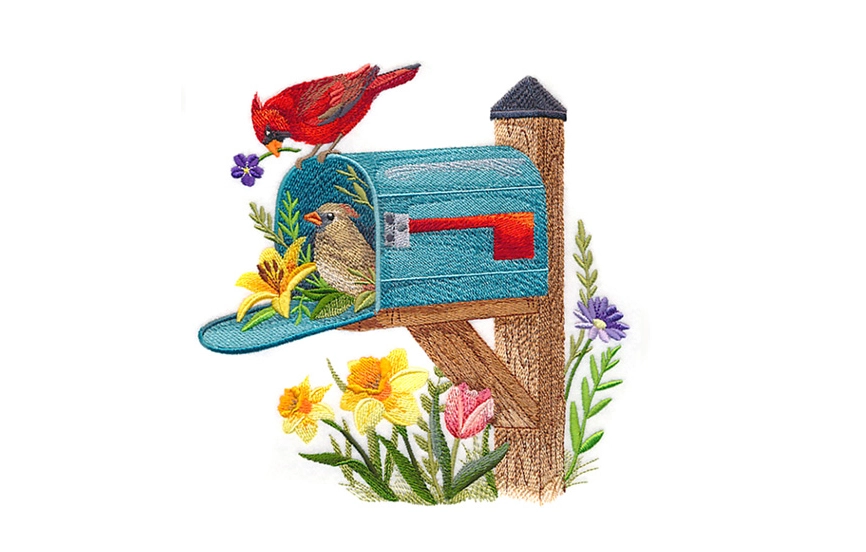Craft a perfectly polished zipper pouch with this specialized embroidery design! Available in three sizes, this project stitches together entirely in-the-hoop, complete with embroidery on both sides and a contrasting lining. Add an optional wrist strap if you like to complete the look. Follow the step-by-step instructions below to stitch your own beautiful zipper pouch!
Supplies
Project Needs & Notes:
- 1/2 yard quilter's cotton or linen (for outer fabric)
- 1/2 yard of quilter's cotton (for lining)
- 1/8 yard thin fabric (for strap and wristlet)
- 1/2" D-ring
- 1/2" swivel clasp
- All purpose zipper (9"+ for small size, 12"+ for medium size, 16"+ for the largest size)
- Temporary spray adhesive (such as Gunold KK100)
- Embroidery thread
- Scissors
- Masking tape or painter's tape
- Soft, fibrous water-soluble stabilizer (such as Vilene)
- Seam ripper
- Quilting ruler
- Iron
- Pressing cloth
- Ironing board
- Hand sewing needle or fabric glue
Designs featured in this tutorial include:
- X14780, Enchanted Autumn Lined Zipper Pouch (In-the-Hoop)
Special note: Because the last color stop of file "b" sews the "a" and "b" pieces together, make sure to completely embroider file "a" before embroidering file "b".
Designs Used

To make a wristlet and D-ring strap for the zipper pouch, cut two strips of the outer fabric or the lining fabric.
For the D-ring strap the strip should be cut to 1 3/4" wide x 7" long.
For the wristlet strap the strip should be cut to 1 3/4" wide x 14" long.
Using a quilting ruler and a rotary cutter is the easiest way to cut out these pieces.
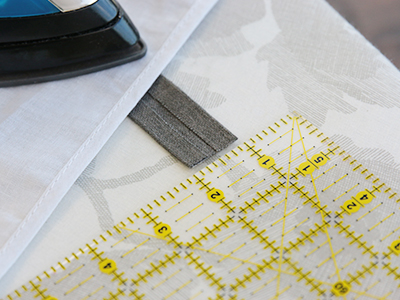
Take either of the two fabric strips, and fold the two long sides over 3/8" with wrong sides together.
Press the folded edge with a pressing cloth.

Then fold the strip in half by matching up the two, long folded edges.
Press the fold, and then either pin or use temporary spray adhesive to hold the fold in place for sewing.

As the stitching will been seen from both sides, wind a bobbin with the same thread you are using in the top needle.

Sew an 1/8" seam along both long sides. You do not need to sew along the two short ends.

Then repeat for the other fabric strip, so both the wristlet and the D-ring strap are folded and sewn. They should both be 1/2" wide when completed.

For the D-ring strap, slide the 1/2" D-ring on to the folded fabric strap.
Center it, and fold the strap so that the flat side of the D-ring is on the inside of the fold.

Pin the fold or use temporary adhesive to hold it while sewing.
Using a matching bobbin, sew a small seam as close to the D-ring and folded end as possible. Make sure your needle does not hit the D-ring as it will break the needle.
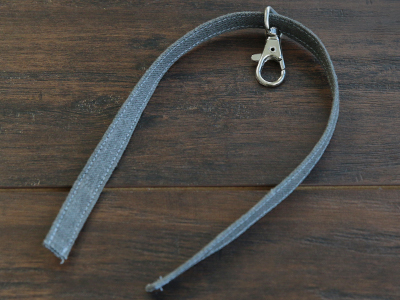
For the wristlet strap, slide the 1/2" swivel clasp onto the sewn fabric strap.

Fold the strap in half again, so the swivel clasp is right at the fold. This time, however, it is very important that the actual clasp of the swivel clasp is on the inside of the fold, so when you fold the fabric it ends up inside of the folded strap.

With the clasp still on the inside of the fold, match up the short, raw edges, and sew a 1/4" seam along them.

Trim the seam allowance as much as possible, and turn the strap right side out. Turning the strap right side out will put the exposed seam allowance on the inside of the fabric loop, and now the actual clasp will be on the outside.
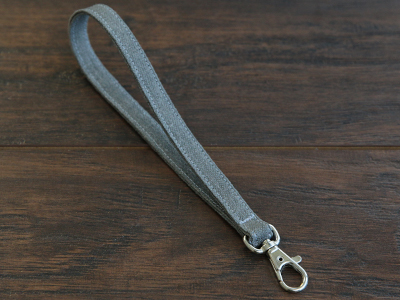
Slide the swivel clasp down until it is resting against the sewn seam. Fold the fabric loop in half, so the seam is right on the fold.
Pin the fold or use temporary spray adhesive to hold it in place while sewing. Then sew a short seam as close to the flat end of the swivel clasp as possible without hitting it with the needle.

This completes the wristlet and the D-ring strap. Set them both aside for now. The D-ring strap will be added during the second file of the embroidery design. The wristlet will be added at the very end.
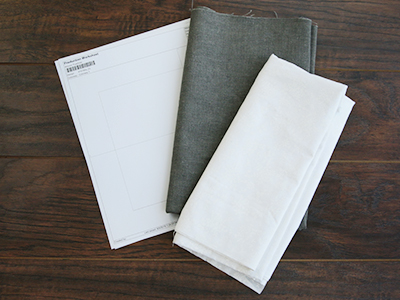
When you download the in-the-hoop zipper pouch design, you will find multiple files. Some are the embroidery files, and the others are dieline files marked with the letters "DL". Dielines are used to cut the fabric to the correct shape and size.
Open and print each dieline file using an embroidery software. If you do not have an embroidery software, Wilcom TrueSizer is a free program to use.
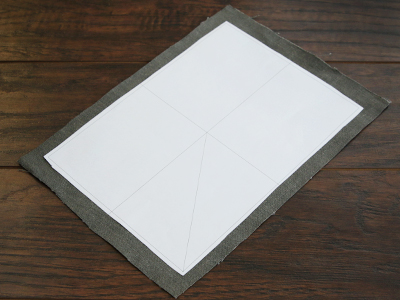
Spray the back side of the first paper dieline (file "a") with temporary adhesive. Smooth it onto the right side of the outer fabric.

Cut out the first piece, and remove the paper dieline.

Repeat to cut the lining, back dieline shape (labeled with a "b" and "back") out of the lining fabric.
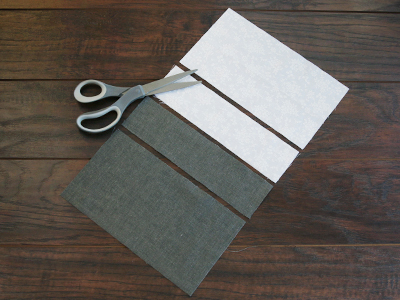
Then take the two remaining front dieline shapes (labeled with a "b", "front", and either "top" or "bottom"), and cut the two shapes out of both the lining and the outer fabrics.

Then take one of the "b", "front shapes, and fold one long side over 1/2". Press it along the folded edge.

Repeat to press one long edge over 1/2" on each of the four front, dieline pieces.
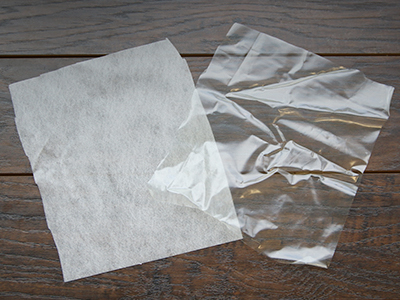
There are different kinds of water-soluble stabilizer. For best results, use a soft and fibrous water soluble stabilizer, like Vilene. Using a stabilizer like this will make the zipper pouch less bulky and easier to turn. The clear and plastic water soluble stabilizer will not work well.
Use a size 11 or 75/11 sharp sewing needle. A sharp sewing needle has a smaller, finer point than an embroidery needle. That means it will make smaller holes in the stabilizer.
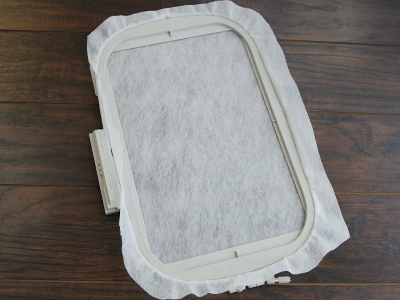
Hoop a piece of water-soluble stabilizer tightly, making sure there are no wrinkles and the stabilizer is taut in the hoop.

Load the back embroidery file (file "a") onto the machine, and begin to embroider the design.
The first thing to sew will be the "back piece dieline". This marks the area on the stabilizer where the fabric piece will be placed.

Remove the hoop from the machine, but do not unhoop the stabilizer. Spray the back of the "a" fabric piece with temporary adhesive, and smooth it in place right inside the sewn dieline.

Reattach the hoop on the machine, and continue embroidering the design. A tackdown stitch will sew next. This binds the fabric piece to the stabilizer for the remainder of the design.

Then follow the color change sheet, and embroider all the inner details of the design.

Once the embroidery is finished sewing, trim or tear away the excess stabilizer from around the back piece.

Once the back (file "a") is completed, hoop another piece of water-soluble stabilizer, and load the front (file "b") onto the machine. The first thing to sew will be the "zipper dieline". This marks the place where the zipper will be placed on the stabilizer.

The zipper dieline sews a box with a centerline through the middle. To place the zipper correctly, close the zipper, and match up the center of the zipper (the teeth that zip and unzip) with the sewn centerline.
Make sure the wrong side of the zipper is against the stabilizer, and tape it in place. The zipper should hang over the hoop on both sides, and will be trimmed away later.

Once the zipper is taped down, place the hoop back on the machine, and embroider the "zipper tackdown" step. This will stitch the zipper to the stabilizer, and hold it in place for the remainder of the design.
Don't worry if it sews over the tape, it can be easily torn away from around the stitches. Then remove the tape before continuing to embroider.

Remove the tape, and embroider the "top front piece dieline" step. This will sew out an outline where the top front fabric piece will go.

Spray the back side of the folded, top front "b" outer fabric piece with temporary adhesive. With the folded edge against zipper, smooth the fabric piece inside the sewn dieline shape.

Then continue to embroider the "top front piece tackdown" step.

The "bottom front piece dieline" will embroider next, showing where to place the next fabric piece.

After the "bottom front piece dieline" has sewn out, place the fabric piece with the folded edge along the zipper, and embroider the tackdown. Again make sure the folded edge is against the zipper.

Then follow the color change sheet to embroider all of the inner details of the design. Stop before sewing the "top lining tackdown".

Before sewing the "top lining tackdown", stop the machine, and remove the hoop without unhooping the design. Lay it on the table with the back side of the hoop facing up.
Take the top, front "b" lining piece, and spray the wrong side with temporary adhesive. Smooth it in place directly behind the top, front "b" outer piece on the back of the hoop. Make sure the folded edge is against the zipper.

As the stitching will now be seen from both sides of the design, wind a bobbin with thread matching the color of the lining fabric. The top thread should still match the outer fabric color.

Place the hoop back onto the machine, and embroider the "top lining tackdown" step. This will sew over the existing sewn tackdown on the front side of the design while also tacking down the added lining fabric.
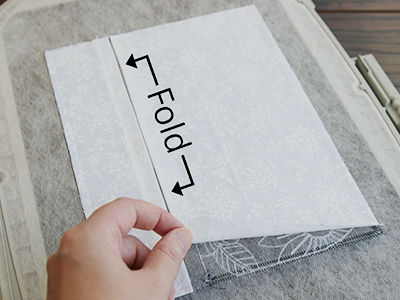
Then repeat to spray and place the bottom, front "b" lining fabric on the back side of the hoop.
Again make sure the folded edge of the fabric is against the zipper.

Still using the matching bobbin, place the hoop back on the machine, and embroider the "bottom lining tackdown".
This will sew over the existing sewn tackdown on the front side of the design while also tacking down the added lining fabric.

Before sewing the "front finishing seam" step, stop the machine and remove the hoop without unhooping the design.
It is very important to move the slider (also called the pull tab) of the zipper to the center of the fabric pieces. This will allow the zipper slider to be on the finished pouch.
If you do not move it, the zipper will be unusable, so do not forget!

It is now time to add the previously made D-ring strap.
Position it as desired so the raw edge is hanging over the outside of the fabric pieces. It is very important to make sure the metal D-ring is far enough away from the outer edge of the fabric that it will not get sewn over. If the metal D-ring does get sewn over by the remaining stitching, it will break your needle, so be sure to place it correctly. Tape it in place.
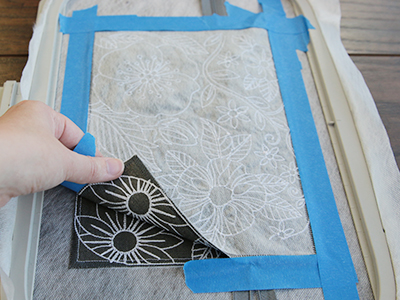
Lay the back piece (file "a") on top of the hooped front piece (file "b") with right sides together. Match up the outer edges, and tape the back piece in place around all four sides of the design.

Place the hoop back onto the machine, and embroider the "front finishing seam" step. This will bind all the layers together, and create the final shape of the pouch.
Remove the tape after embroidering this step.

Then remove the hoop from the machine, and turn it over so the lining fabric is facing up. Lay the lining "b" back piece on top of the other lining pieces with right sides together. Match up the edges, and tape it in place.

Place the hoop back onto the machine, and embroider the final "lining finishing seam" step. This will sew the final shape of the pouch a second time, binding the last lining piece to the rest of the design.

The "lining finishing seam" will also leave an opening in the bottom edge of the lining for turning the pouch right side out. So make sure to not just sew either finishing seam step twice as the two finishing seams being different is very important.

Once the design has finished embroidering, cut or tear away the excess stabilizer from around the design.

Then trim away the seam allowance as well as the extra zipper length. Trimming the fabric away from the corners and curves will help the pouch keep its shape without wrinkling once turned right side out.

Turn the zipper pouch right side out through the opening in the lining, so the right side of the lining fabric is facing out.

Then use fabric glue or a hand sewing needle and thread to close the opening in the bottom edge of the lining.

Cut open the stabilizer hiding the zipper using a scissor or seam ripper. Make sure not to cut the actual zipper or fabric.

Turn the pouch right side out. If desired, you can remove the water soluble stabilizer inside of the pouch to make it less bulky.
To do this, follow the manufacturer's instructions that come with the stabilizer. For Vilene, we soaked the pouches overnight (12+ hours), and then scrubbed the pouch gently under running water to remove the stabilizer completely so that no stiffness remained.
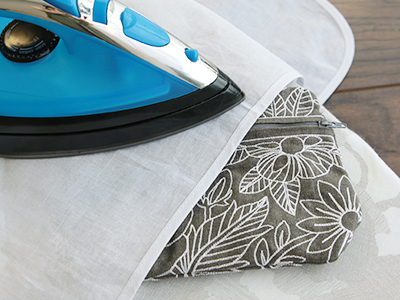
Allow the pouch to air dry, and then press it with a pressing cloth and an iron to get rid of wrinkles and create crisp, folded edges.

Then clip the previously made wristlet with the swivel clasp onto the D-ring strap.


